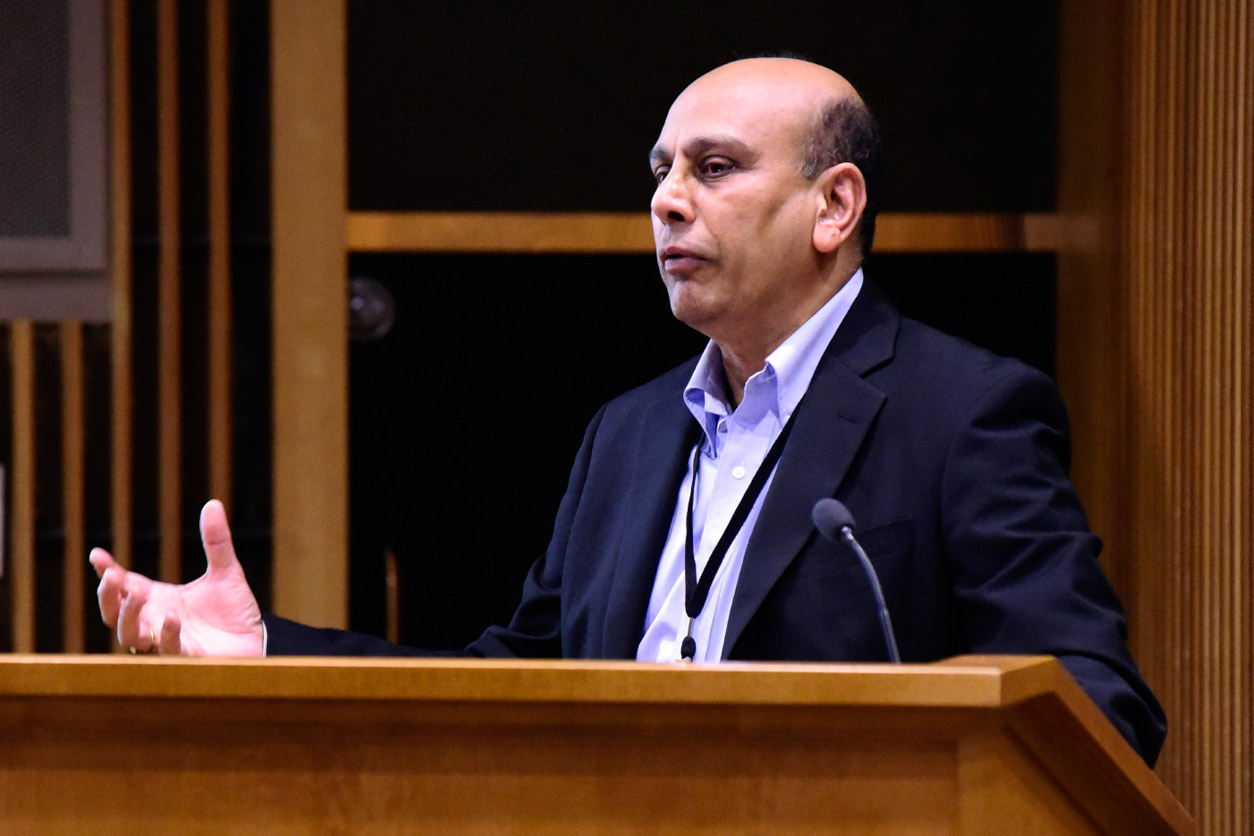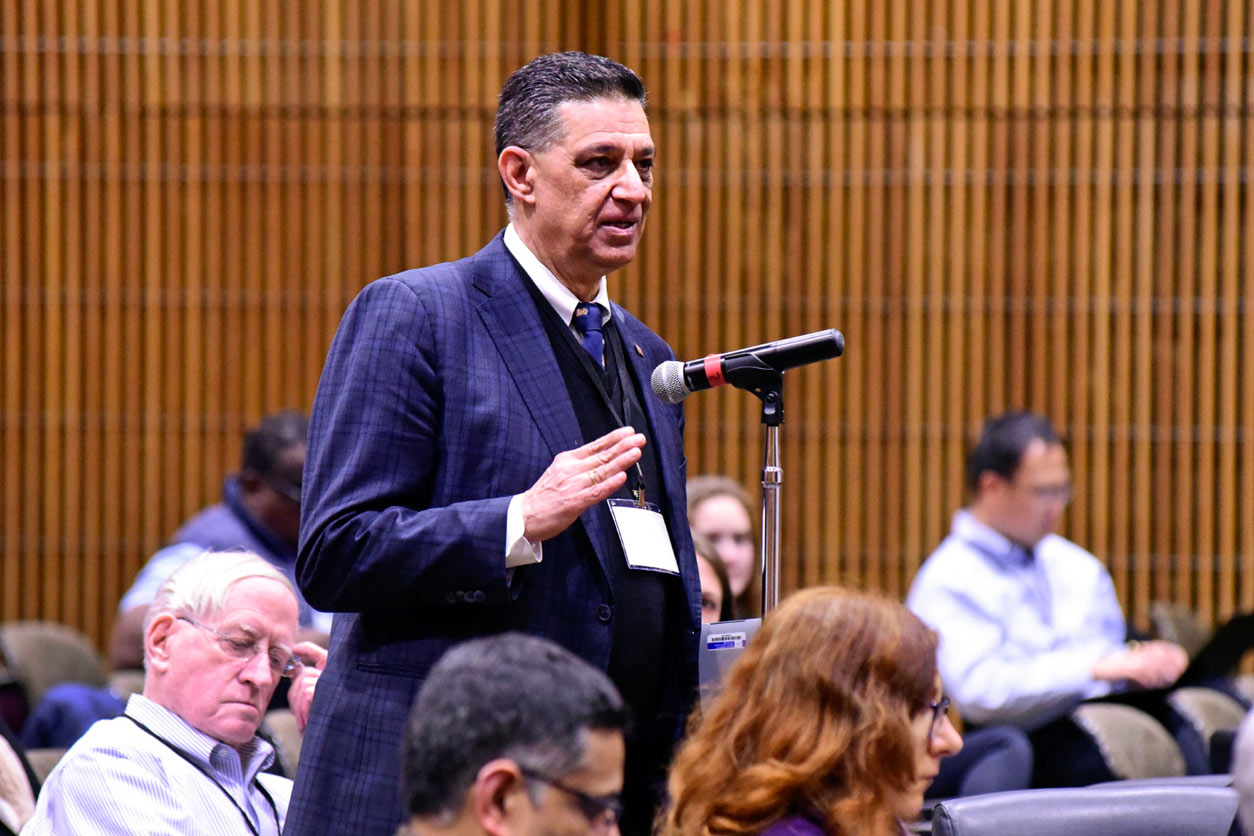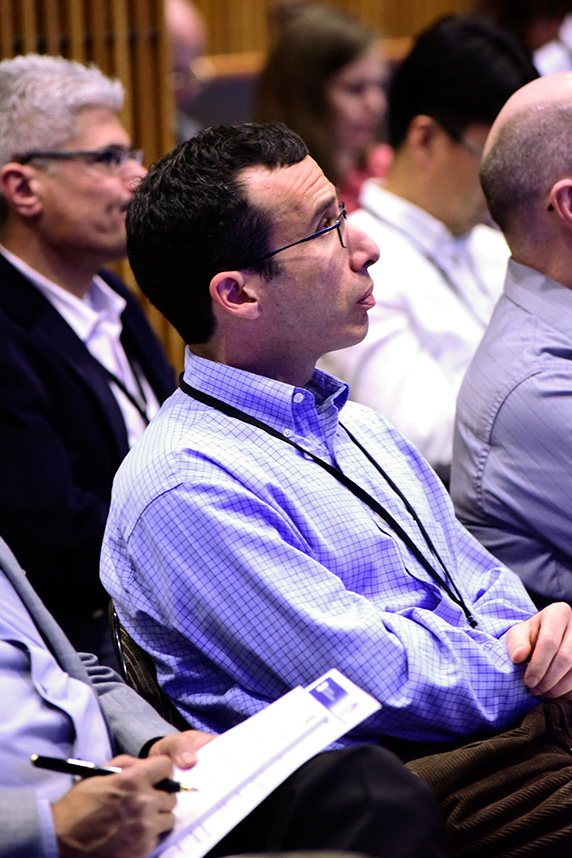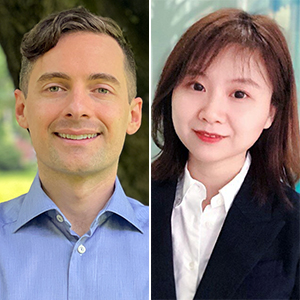Researchers from around the country gathered to discuss an area of broad importance at the National Institutes of Health (NIH) — inflammation, its resolution, and especially, the failure to resolve, which leads to chronic inflammation.
The Inflammation Resolution Biology Workshop, an NIH wide initiative, was planned to assess scientific understanding of inflammation and to develop coordinating strategies to promote this research area across NIH. The March 25-26 event was held at NIEHS.
“Inflammation is involved in diseases such as asthma, cancer, diabetes, and obesity,” said Sri Nadadur, Ph.D., program officer in the NIEHS Division of Extramural Research and Training and co-organizer of the workshop. “Many environmental agents can also be linked to inflammation.”
 “Our hope is that this workshop will help us understand the role of unresolved inflammation in disease,” said Nadadur, during a welcome speech at the Inflammation Resolution Biology Workshop. (Photo courtesy of Steve McCaw)
“Our hope is that this workshop will help us understand the role of unresolved inflammation in disease,” said Nadadur, during a welcome speech at the Inflammation Resolution Biology Workshop. (Photo courtesy of Steve McCaw)The body triggers inflammatory processes as a protective response to infection, injury, or surgical trauma. However, when left unchecked, chronic inflammation can lead to tissue damage and disease. The process has four distinct phases — response, regulation, resolution, and restoration, which refers to returning the body to its normal, healthy state. The March workshop focused specifically on the third phase, resolution.
“Inflammation is a dynamic process involving diverse players and pathways in the body,” said NIEHS and National Toxicology Program Director Linda Birnbaum, Ph.D. “Emerging science is pointing to the direction that unresolved inflammation is a significant contributor to multiple diseases.”
SPMs showcase in a variety of diseases
Previously, inflammation resolution was thought to be a passive process, but recent studies have shown that it is an active process driven by a newly discovered family of specialized pro-resolving mediators (SPMs).
 “Aging and diet are the new villains to consider when thinking about inflammation,” said Serhan, while participating in a discussion session. (Photo courtesy of Steve McCaw)
“Aging and diet are the new villains to consider when thinking about inflammation,” said Serhan, while participating in a discussion session. (Photo courtesy of Steve McCaw)Speakers discussed a variety of diseases in the context of how researchers had come to better understand SPMs. Charles Serhan, Ph.D., from Harvard University, described his identification of newly discovered SPMs, known as resolvins, protectins, and maresins.
His lab is working to profile the various SPMs in various tissues in the body and in bone marrow, breast milk, and tears, with the ultimate goal of developing therapies.
Other workshop participants explore the roles these SPMs play lung diseases like asthma and chronic obstructive pulmonary disease (COPD), as well as in cancer and vascular injury.
Inflammation and chemical exposures
Sven Jordt, Ph.D., from Duke University, is part of the CounterAct Program, another NIH wide initiative that NIEHS helps fund.
 In her presentation, Poole explained her research on lung inflammation in farmers in Nebraska. The condition is often due to the microbes in the dust they inhale. (Photo courtesy of Steve McCaw)
In her presentation, Poole explained her research on lung inflammation in farmers in Nebraska. The condition is often due to the microbes in the dust they inhale. (Photo courtesy of Steve McCaw)“The CounterAct Program focuses on treatment for injuries from chemical threats, such as chlorine gas, mustard gas, or tear gas agents,” said Jordt. “Exposure to these agents can cause a strong inflammatory response. Our objective is to test the protective effects of several known resolving agents to reduce acute inflammation.”
Jill Poole, Ph.D., from the University of Nebraska, shared her work using animal models to study airway inflammation after exposures to microbial-enriched dust that farmers often encounter.
Contributes to aging process
“The aging process is characterized by a pro-inflammatory state, with high circulating levels of inflammatory molecules,” said Luigi Ferrucci, M.D., Ph.D., scientific director of the National Institute of Aging. He used the term inflammaging to describe the study of inflammation through the lens of aging.
“Inflammation is why people, when they are older, are more likely to develop disabilities,” he said. “Are there ways we can prevent or slow down this process?”
 Ferrucci is a geriatrician and epidemiologist who conducts research on causal pathways that lead to progressive physical and cognitive decline in older persons. (Photo courtesy of Steve McCaw)
Ferrucci is a geriatrician and epidemiologist who conducts research on causal pathways that lead to progressive physical and cognitive decline in older persons. (Photo courtesy of Steve McCaw)He discussed the Women’s Health and Aging Study, in which his research team used walking speed as a predictor of health. The faster you walk, the healthier you may be. They measured levels of an inflammatory molecule, known as interleukin-6 (IL-6), and compared it with walking speed.
 Fessler, head of the NIEHS Immunity, Inflammation, and Disease Laboratory, another of the conference speakers, listened to his colleagues’ research. (Photo courtesy of Steve McCaw)
Fessler, head of the NIEHS Immunity, Inflammation, and Disease Laboratory, another of the conference speakers, listened to his colleagues’ research. (Photo courtesy of Steve McCaw)The team found that having higher levels of IL-6 were associated with slower walking speeds, and therefore, may be predictive of aging.
Next steps in inflammation resolution research
The talks were followed by a panel discussion in which the speakers mulled over big questions in the field and worked to find a path forward.
“For the past two to three years, we have been having discussions surrounding this emerging field of inflammation resolution biology,” said Nadadur. “As this knowledge may be used for intervention strategies, this workshop helps bring together that knowledge.”
(Sheena Scruggs, Ph.D., is the digital outreach coordinator in the NIEHS Office of Communications and Public Liaison.)









